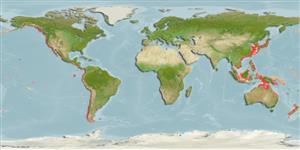Thysanocardia nigra (Ikeda, 1904)
| Native range | All suitable habitat | Point map | Year 2050 |

|
| This map was computer-generated and has not yet been reviewed. |
| Thysanocardia nigra AquaMaps Data sources: GBIF OBIS |
Google image |
No photo available for this species.
Classification / Names Common names | Synonyms | CoL | ITIS | WoRMS
Not assigned | Sipuncula | Golfingiidae
Environment: milieu / climate zone / depth range / distribution range Ecology
Benthic; depth range 1 - 120 m (Ref. 1840). Subtropical
Distribution Countries | FAO areas | Ecosystems | Occurrences | Introductions
Pacific Ocean. Tropical to boreal.
Length at first maturity / Size / Weight / Age
Maturity: Lm ? range ? - ? cm Max length : 10.0 cm TRKL male/unsexed; (Ref. 1840); common length : 5.0 cm TRKL male/unsexed; (Ref. 1840)
Short description Morphology
Life cycle and mating behavior Maturity | Reproduction | Spawning | Eggs | Fecundity | Larvae
Main reference
References | Coordinator | Collaborators
Maiorova, A.S. and A.V. Adrianov 2005 Ultrastructure of Microvillar Coelomocytes from the Trunk Coelom of Thysanocardia nigra Ikeda, 1904 (Sipuncula) from the Sea of Japan. Russian Journal of Marine Biology. 31(3):192-195. (Ref. 1783)
IUCN Red List Status
(Ref. 130435: Version 2025-1)
CITES status (Ref. 108899)
CMS (Ref. 116361)
Threat to humans
Human uses
| FishSource |
Tools
More information
Diet composition
Food consumption
Predators
Max. ages / sizes
Length-weight rel.
Length-length rel.
Length-frequencies
Mass conversion
Abundance
Maturity
Fecundity
Spawning
Eggs
Egg development
Larvae
Internet sources
BHL | BOLD Systems | CISTI | DiscoverLife | FAO(Publication : search) | Fishipedia | GenBank (genome, nucleotide) | GloBI | Gomexsi | Google Books | Google Scholar | Google | PubMed | Tree of Life | Wikipedia (Go, Search) | Zoological Record


